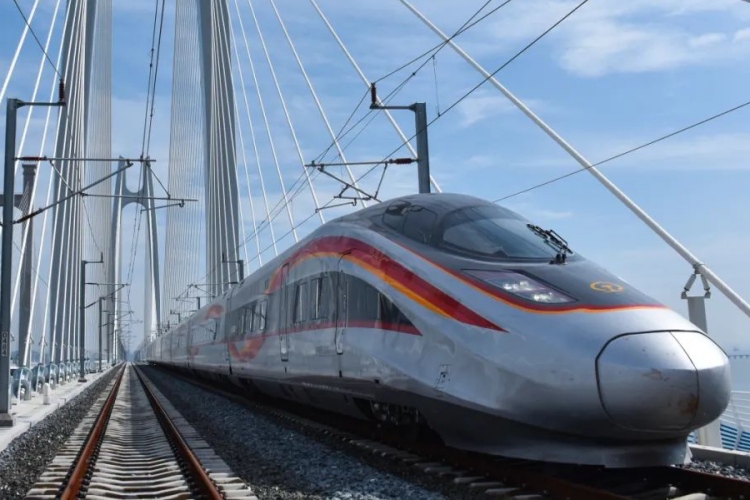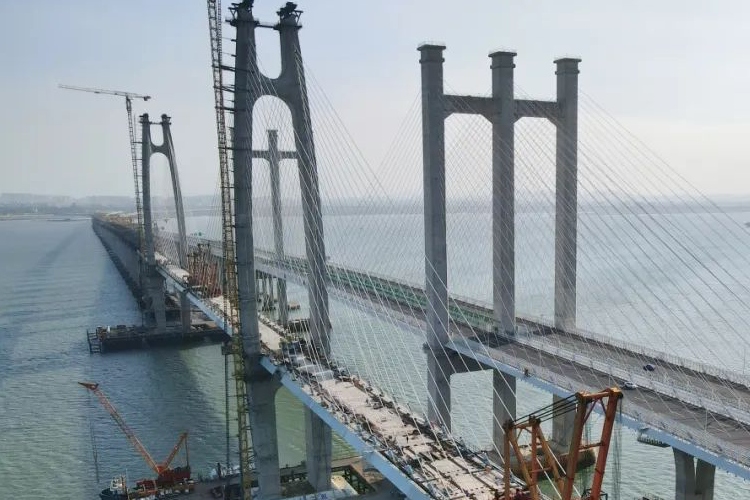With the application of new technology, materials, and equipment, the Fujian-Xiamen High-Speed Railway Bridge constructed by CCCC demonstrates its technological appeal.
On September 28, 2023, China's first cross-sea high-speed railway, the Fujian-Xiamen high-speed railway, was officially opened. With a sea-crossing length of over 20 kilometers, it comprises three sea-crossing bridges from north to south: the Meizhou Bay cross-sea bridge, China's first extradosed cable-stayed bridge on a sea-crossing high-speed railway; the Quanzhou Bay cross-sea bridge, China's first cross-sea high-speed rail bridge; and the Anhai Bay Grand Bridge, China's first ballastless track laid on a cross-sea bridge.
Quanzhou Bay cross-sea bridge
Sea-crossing high-speed railway with a speed of 350 kilometers per hour.
The sea-crossing high-speed railway, with a speed of 350 kilometers per hour, utilizes ballastless tracks to ensure the smooth and rapid movement of trains. The Anhai Bay Grand Bridge adopts relevant aerodynamic measures and is laid with CRTSⅠballastless tracks, marking a pioneering achievement in the world of ballastless track bridges for its large span across the sea.
At the Quanzhou Bay cross-sea bridge, a ballasted track can also achieve the smoothness of a ballastless track. Using a polyurethane railway track bed, loose aggregate stones are bonded together, preventing the scattering of ballast and allowing high-speed trains to maintain their designed speed of 350 kilometers per hour while crossing the sea.
Ballastless track
Steel Chinese dragon resistant to corrosion and wind
The high-speed railway passes through Quanzhou Bay, characterized by strong tidal currents, making operations on sea challenging due to high winds, rough waves, and corrosive environments.
The project team overcame these challenges by employing new materials, equipment, and techniques. High-nickel weather-resistant steel was used to protect the steel anchor beams, and the world's first thousand-ton-level high-speed box girder erection machine, the "Kunlun," with a length of 116 meters and a height of 9.3 meters. In operation, it can withstand up to a level 7 wind, greatly ensuring efficient bridge construction. The bridge construction utilized Building Information Modeling (BIM) technology, enabling designers to selectively reinforce and strengthen key areas of the bridge to withstand strong winds and seismic impacts.
Since the opening of the Fujian-Xiamen high-speed railway, daily passenger flow has reached 24,000, creating a "one-hour living circle" between Fuzhou and Xiamen and a half-hour transportation circle between Xiamen, Zhangzhou, and Quanzhou, connecting the coastal cities of Southeast China into a "golden tourism belt".
"I live in Putian and work in Quanzhou. It only takes me over 20 minutes to commute across the sea by high-speed rail," said Ms. Yu, who works in e-commerce. With the cross-sea bridges of the Fujian-Xiamen High-Speed Railway, her "dual-city life" has become much more convenient.





